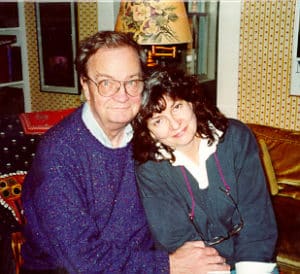Poet Jane Kenyon (1947-1995) met poet Donald Hall (1928-2018) at the University of Michigan. He was teaching; she was a student. They married in 1972, and in 1975 moved to Eagle Pond Farm in New Hampshire, which had been his grandparents’ home. They were married until her death from leukemia in 1995.
Hall’s career loomed larger. By the time they met, he had already been the editor of Oxford Poetry, literary editor of Isis, editor of New Poems, the recipient of several literary prizes and recognitions, the author of several volumes of poetry, and the first poetry editor of The Paris Review. He was a presence in the poetry world; she was just starting out. By all accounts, they were devoted to each other.

Donald Hall and Jane Kenyon
Even as he gained recognition and accolades, she was building her own poetic reputation. She published four poetry collections: From Room to Room, The Boat of Quiet Hours, Let Evening Come, and Constance. She translated and published a collection of poems by the Russian poet Anna Akhmatova. Kenyon was servingas New Hampshire’s poet laureate at the time of her death. After her death, three more collections of her writing were published: Otherwise: New & Selected Poems, A Hundred White Daffodils: Essays, Interviews, The Akhmatova Translations, Newspaper Columns, and One Poem, and Collected Poems.
Hall died in 2018, but before he did, he selected 74 poems he considered to be her best. Graywolf Press published them this year under the title The Best Poems of Jane Kenyon. The poems are classic Kenyon. Generally short, with a couple of notable exceptions, the poems show Kenyon’s mastery over the small but important things of everyday life. You won’t find popular academic words or trendy commentaries on current events. Instead, you find deep, often profound observations of daily living: the seasons, times of the day, a valentine, vegetables, what she’s reading—the kinds of things the vast majority of us understand and identify with.
Her language is simple, almost deceptively so. She tells short stories. She’s very precise; she says what needs to be said and no more. A poem about a quiet afternoon describes a place where many of us have been—trying to write something.
Afternoon in the House

sprawl, each
in a favored place.
The geranium leans this way
to see if I’m writing about her:
head all petals, brown
stalks, and those green fans.
So you see,
I am writing about you.
I turn on the radio. Wrong.
Let’s not have any noise
in this room, except
the sound of a voice reading a poem.
The cats request
The Meadow Mouse, by Theodore Roethke.
The house settles down on its haunches
for a doze.
I know you are with me, plants,
and cats—and even so, I’m frightened,
sitting in the middle of perfect
possibility.
Of special note are two of the longer poems. “The Stroller” is about the vehicle she was pushed around in as a baby and young child; it becomes a deeply felt series of memories about Kenyon’s father. “Gettysburg: July 1, 1863” is about a dying soldier, and his last thoughts as death closes in around him. Both are extremely moving poems.
The Best Poems of Jane Kenyon, published 25 years after her death, provides a wonderful introduction to the full range of what she accomplished. Her reputation has only grown, and it should.
Related:
Evening Loveliness: Poets Jane Kenyon & Sara Teasdale
Journey into Poetry: Julie L. Moore
Poets and Poems: Donald Hall and Selected Poems
Donald Hall’s Amanuensis – The Paris Review
Photo by Jeffrey Turner, Creative Commons, via Flickr. Post by Glynn Young.
__________________________

“I require all our incoming poetry students—in the MFA I direct—to buy and read this book.”
—Jeanetta Calhoun Mish
- Poets and Poems: Mary Brown and “Call It Mist” - September 18, 2025
- “Horace: Poet on a Volcano” by Peter Stothard - September 16, 2025
- Poets and Poems: The Three Collections of Pasquale Trozzolo - September 11, 2025

Nigel Kent says
Kenyon is a wonderful poet. If you haven’t read her her collections are a real treat. Pleased to see Glynn drawing attention to her work.
Mary Sayler says
Thanks for reminding us of her work, Glynn. Once the poetry of Mary Oliver brought me back to poetry writing, I searched the works of other poets, trying to find ones with whom I could relate. The first book I recall loving (after Oliver’s) was Jane Kenyon’s Otherwise. Then I heard she’d died – so young – and right when I’d “found her.” What a loss!
Sandra Heska King says
I was in Ann Arbor when Kenyon was there. I wonder if I brushed up against her on the corner or in a store or strolling across the campus. Maybe she was even a patient in the doctor’s office I worked in. (Reminder: I’m not a Wolverine–I just lived and worked in A2.) I always wonder these things when I learn I could have had a close encounter and hope some creative dust might still swirl around me like Linus.